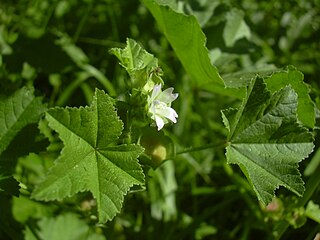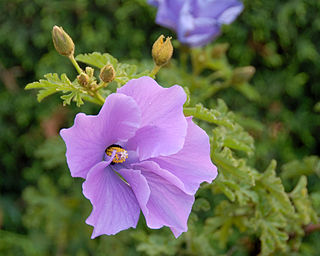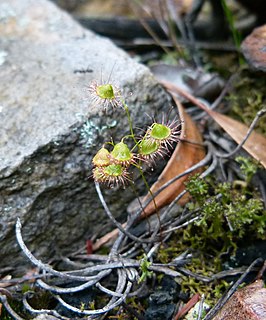
Hibiscus is a genus of flowering plants in the mallow family, Malvaceae. The genus is quite large, comprising several hundred species that are native to warm temperate, subtropical and tropical regions throughout the world. Member species are renowned for their large, showy flowers and those species are commonly known simply as "hibiscus", or less widely known as rose mallow. Other names include hardy hibiscus, rose of sharon, and tropical hibiscus.

Malvaceae, or the mallows, is a family of flowering plants estimated to contain 244 genera with 4225 known species. Well-known members of economic importance include okra, cotton, cacao and durian. There are also some genera containing familiar ornamentals, such as Alcea (hollyhock), Malva (mallow) and Lavatera, as well as Tilia. The largest genera in terms of number of species include Hibiscus, Sterculia, Dombeya, Pavonia and Sida.

Hibiscus rosa-sinensis, known colloquially as Chinese hibiscus, China rose, Hawaiian hibiscus, rose mallow and shoeblack plant, is a species of tropical hibiscus, a flowering plant in the Hibisceae tribe of the family Malvaceae. It is widely cultivated in tropical and subtropical regions, but is not known in the wild, so that its native distribution is uncertain. An origin in some part of tropical Asia is likely. It is widely grown as an ornamental plant in the tropics and subtropics.

Hibiscus tiliaceus is a species of flowering tree in the mallow family, Malvaceae, that is native to the Old World tropics. Common names include sea hibiscus, beach hibiscus, coastalhibiscus, coastalcottonwood, green cottonwood, native hibiscus, native rosella, cottonwood hibiscus, kurrajong, sea rosemallow, balibago (Tagalog), malabago or malbago, maribago, lambago, waru (Javanese), baru or bebaru (Malay), dhigga (Maldivian), pagu (Chamorro), hau (Hawaiian), fau (Samoan), purau (Tahitian), and vau tree. The specific epithet, "tiliaceus", refers to its resemblance of the leaves to those of the related Tilia species.

Malvoideae is a botanical name at the rank of subfamily, which includes in the minimum the genus Malva. It was first used by Burnett in 1835, but was not much used until recently, where, within the framework of the APG System, which unites the families Malvaceae, Bombacaceae, Sterculiaceae and Tiliaceae of the Cronquist system, the aggregate family Malvaceae is divided into 9 subfamilies, including Malvoideae. The Malvoideae of Kubitzki and Bayer includes 4 tribes:

Lagunaria is a genus in the family Malvaceae. It is an Australian plant which is native to Lord Howe Island, Norfolk Island and parts of coastal Queensland. It has been introduced to many parts of the world. The genus was named for its resemblance to the earlier genus Laguna Cav., which was named in honour of Andrés Laguna, a Spanish botanist and a physician to Pope Julius III.

Hibiscus insularis, the Phillip Island hibiscus, is a species of flowering plant in the mallow family Malvaceae, that is endemic to Phillip Island, a small island to the south of Norfolk Island, Australia. The entire natural extent of this species is just two small clumps, and each clump apparently consists of multiple separate stems of a single genotype. It has been propagated and planted more widely on Phillip Island, but only vegetatively which does not increase the genetic diversity. Seedlings apparently have not been observed in the wild. It produces greenish-yellow flowers that fade to mauve through most of the year.

Cyrtostylis, commonly known as gnat orchids, is a genus of five or six species of flowering plants in the orchid family Orchidaceae and is native to Australia and New Zealand. Cyrtostylis orchids often form dense colonies of genetically identical plants. They have a single heart-shaped leaf and a thin flowering stem with pale coloured insect-like flowers. The lateral sepals and petals are similar in size and colour but the labellum is shelf-like and conspicuous with two prominent glands at its base.

Hibiscus calyphyllus, the lemonyellow rosemallow, is a shrub from tropical Africa belonging to the genus Hibiscus. In 1883 this Hibiscus was offered for sale in England under the name Hibiscus chrysanthus with Port Natal, Cape Colony, identified as the source. By 1891 the same Hibiscus was identified as Hibiscus chrysantha in the United States, a practice which may have continued into the 1930s and contributed to incorrect species identification. In 1892 the name Hibiscus calycinus was designated as the correct name for the species; but, by 1894 the currently accepted name Hibiscus calyphyllus is found in association with Hibiscus calycinus. At the beginning of the 20th century, this Hibiscus was sold as seeds in the United States under the name Hibiscus Giant Yellow. Because of the similarity of the flowers, it is quite common to find Abelmoschus manihot confused with Hibiscus calyphyllus in the early 20th century gardening literature of the United States, particularly in the area of cold tolerance. If the species identification is correct, the 1903 report in The Flower Garden states that: "Giant Yellow is a beautiful canary yellow with crimson throat, hardy as far north as St. Louis, but safer in the cellar above that latitude", then Hibiscus calyphyllus may have some degree of cold tolerance. St. Louis, Missouri is in USDA Zone 6a but there are currently no reports of Hibiscus calyphyllus overwintering in USDA Zone 6a; it is known to overwinter successfully in USDA Zone 8a.

Alyogyne huegelii is a flowering plant found in the Southwest botanical province of Western Australia, extending along its entire coastline. A large flowered shrub, the species favours the sands of coastal shrublands and heath.

Iliamna is a small genus of flowering plants in the mallow family, endemic to North America. It is related to the bush mallows of California (Malacothamnus) and to Phymosia of Mexico, Central America and the Caribbean. These perennial herbs are known commonly as wild hollyhocks and sometimes as globe mallows, Kankakee mallow, Kankakee globe mallow, and Streambank wild hollyhock. More often, the latter terms refer to members of the genus Sphaeralcea, which belong, like Iliamna, to the "typical" mallow tribe (Malveae) of the mallow and hibiscus subfamily Malvoideae. The name of the genus, proposed by Edward Lee Greene, appears to be a reference to Iliamna Lake in Alaska, even though the genus Iliamna does not occur in Alaska

Alyogyne hakeifolia is a species of flowering plant in the family Malvaceae. It is endemic to the southern regions of Australia. The plant is similar to a Hibiscus and was assumed to be part of that genus for many years. It is known to have been cultivated in England since the mid nineteenth century.

Drosera huegelii, the bold sundew, is an erect perennial tuberous species in the carnivorous plant genus Drosera that is endemic to Western Australia. It grows in sandy soils in winter-wet depressions and margins of swamps and occurs along the south-west coast of Australia. D. huegelii produces small, bell-shaped leaves along an erect stem that can be 10–50 cm (4–20 in) tall. White to cream-coloured flowers emerge from June to September.
Radyera is a genus of flowering plants in the family Malvaceae.
Hibiscus cravenii is a species of flowering plant in the mallow family, Malvaceae, that is endemic to the Northern Territory in Australia.
Lyndley Alan Craven was a botanist who became the Principal Research Scientist of the Australian National Herbarium.

Grevillea huegelii, commonly known as comb grevillea, is a shrub that is endemic to southern Australia. The species was first formally described by botanist Carl Meissner in Plantae Preissianae in 1845.

Tectocoris diophthalmus, commonly known as the hibiscus harlequin bug or cotton harlequin bug, is the sole member of the genus Tectocoris. It is a brightly coloured convex and rounded shield-shaped bug with a metallic sheen that grows to about 20 mm. Adult females are mostly orange and males are both blue and red or orange, while nymphs are typically metallic green and purple. The colours are quite variable, and experiments suggest that the variation in colour may reduce bird predation, especially on the immature stages. This extreme level of variation is such that different taxonomists have, since 1781, described this species under different new names at least 16 times, some of these supernumerary names remaining in use until 2006, when it was finally confirmed that they were all colour forms of a single organism. It is common in Eastern Australia, New Guinea and several Pacific Islands in habitats ranging from urban to agricultural and coastal areas.
Macrostelia is a genus in the tribe Hibisceae - in the family Malvaceae. The genus consists of three species: M. calyculata Hochr., M. involucrata Hochr., and M. laurina (Baill.) Hochr. & Humbert. Macrostelias - all native to Madagascar - distinguish themselves from most other genera in Hibisceae by typically bearing flowers with a long corolla tube. Although members of Hibiscus - an example of one of these other genera - may bear flowers with proximally connate petals, such connation occurs only at the very base of the petals.
Ptilothrix is a genus within the tribe Emphorini of the family Apidae. Bees of this genus can range from 7 to 15 millimeters. Ptilothrix species are solitary ground nesting bees. The genus has especially prominent hairs in the scopae of their hind legs, to help gather pollen to provision their nests. Ptilothrix specialize on certain families of plants for their pollen, including the families Malvaceae, Convolvulaceae, Onagraceae, Cactaceae, Pontederiaceae and Asteraceae. The genus is found in the new world, with species ranging from North to South America.















